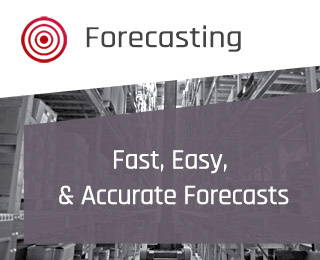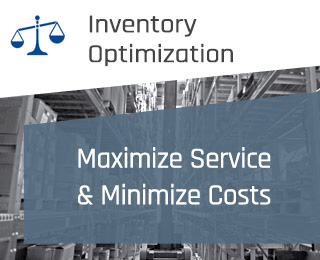VIDEO TUTORIALS:
Best practices for demand forecasting, and inventory planning.
Over the course of these video tutorial series, you’ll be able to identify opportunities to optimize inventory, improve forecast accuracy, and increase revenue. We are offering these tutorials due to our previous webinar series’s popularity featuring Dr. Thomas Willemain, co-Founder and SVP Research at Smart Software. Armed with this information, you’ll be able to:
- Compare the three most used inventory control policies.
- Improve forecast accuracy by measuring forecast error.
- Determine how much to order or manufacture and when (MRP logic).
- Use a specialized algorithmic tournament to estimate the parameters to compute the best forecasts methods.
- Compare the most helpful forecasting techniques.
- Identify and harness leading indicators to achieve more accurate forecasts.
FOUR USEFUL WAYS TO MEASURE FORECAST ERROR
Forecast Accuracy by Managing Error
Forecast Accuracy by Minimizing Error
Forecast Accuracy by Measuring Error
Full-Screen mode: double-click the video once playback has started.
In these videos, Dr. Thomas Willemain, co-Founder and SVP Research, talks about improving forecast accuracy by measuring forecast error. We begin by overviewing the various types of error metrics: scale-dependent error, percentage error, relative error, and scale-free error metrics. While some error is inevitable, there are ways to reduce it, and forecast metrics are necessary aids for monitoring and improving forecast accuracy. Then we will explain how to assess forecasts of multiple items and how it often makes sense to use weighted averages, weighting items differently by volume or revenue. Tom concludes by reviewing the methods to improve forecast accuracy, the importance of measuring forecast error, and the technological opportunities to improve it.
TOP 3 INVENTORY POLICIES
PERIODIC REVIEW POLICY
3 INVENTORY POLICIES – MIN-MAX
ORDER QUANTITY & REORDER POINT
Full-Screen mode: double-click the video once playback has started.
In this Video Series, Dr. Thomas Willemain, co–Founder and SVP Research, defines and compares the three most used inventory control policies. These policies are divided into two groups, periodic review, and continuous review. There is also a fourth policy called MRP logic or forecast based inventory planning which is the subject of a separate video blog that you can see here. These videos explain each policy, how they are used in practice, and the pros and cons of each approach.
FORECAST BASED INVENTORY MANAGEMENT
Full-Screen mode: double-click the video once playback has started.
INVENTORY DYNAMICS
FORECAST BASED INVENTORY – LEAD TIME
HOW MUCH & WHEN TO ORDER
FORECAST BASED INVENTORY – SAFETY STOCK
In this Video Dr. Thomas Willemain, co–Founder and SVP Research, talks about forecast-based inventory management policy, also known as MRP logic. This is the fourth in our series on major approaches to managing inventory. We begin by looking at some very simple and then more robust models of inventory dynamics that help us determine how much to order or manufacture and when. We then consider how to calculate lead time and account for lead time variability. Tom concludes by describing the importance of safety stock, it’s role in properly buffering against demand and supply uncertainty, and how best to calculate it.
AUTOMATIC FORECASTING FOR TIME SERIES DEMAND PROJECTIONS
Full-Screen mode: double-click the video once playback has started.
FORECAST TOURNAMENT
Best Forecast Tournament Options
Forecasting Tournament Examples
Holdout Analysis
FORECASTING TECHNIQUES
Full-Screen mode: double-click the video once playback has started.
SINGLE EXPONENTIAL SMOOTHING
HOLTS METHOD
RIGHT VALUE OF ALPHA
WINTERS METHOD
FORECASTING – REGRESSION ANALYSIS
Full-Screen mode: double-click the video once playback has started.
LINEAR REGRESSION
CAUSAL MODELING REGRESSION
AUTO REGRESSION IN BUSINESS
LEADING INDICATOR REGRESSION
Best practices for Demand Forecasting, and Inventory Planning.
Examples of the benefits and economic impact
Meet Customer Demand
Accounting for inherent demand patterns such as trend and seasonality as well as external and internal feedback on events/promotions minimizes unexpected sales orders that would otherwise be backordered or lost. A service parts distributor increased perfect order fill rate from 92.5% to 95%.
Increase Revenue
Optimizing Inventory Levels means savings realized on one subset of items can be reallocated in order to carry a broader portfolio of “in stock” items allowing revenues to be captured that would otherwise be lost sales. A leading distributor was able to stock a broader portfolio of parts with savings used from inventory reductions and increased part availability by 18%
Reduce Inventory Costs
Less critical Items that are forecasted to achieve 99%+ services levels represent opportunities to reduce inventory. By targeting lower service levels on less critical items, inventory will “right size” over time to the new equilibrium decreasing holding costs and value of inventory on hand. A major public transit system Inventory reduced inventory by more than $4,000,000 while improving service levels.
Improve Planner Productivity
By strategically planning the inventory parameters, planners will spend less time managing outputs from their ERP and have more time to focus on value add activities. Considerable time will also be saved by reducing the number of emergency out of stock events that drain resources. A repair service operation reduced the number of emergency shipments on spare parts by 17% in the first year following implementation.
Reduce Product Costs
Forecasting provides a stronger foundation on which to negotiate with vendors. By using statistical forecasts and estimates of best and worst case demand scenarios, expectations between supplier and customer can be established. After collaborating with a major contract manufacturer using the demand forecast as a guide, An aviation equipment contractor reduced material costs on a major product line by $187,000
Organizational Consensus
When you are able to model and communicate expected demand and likely ranges along with the precise tradeoffs between service levels and inventory cost in your strategic inventory plans, you will establish consensus among all the stakeholders. Once true consensus is established, the organization knows where risks are likely, where they are not, and can plan accordingly.
Contact Us Today for More Information
If you request a demo, one of our specialists will show you how Smart can help, using your own inventory data!









